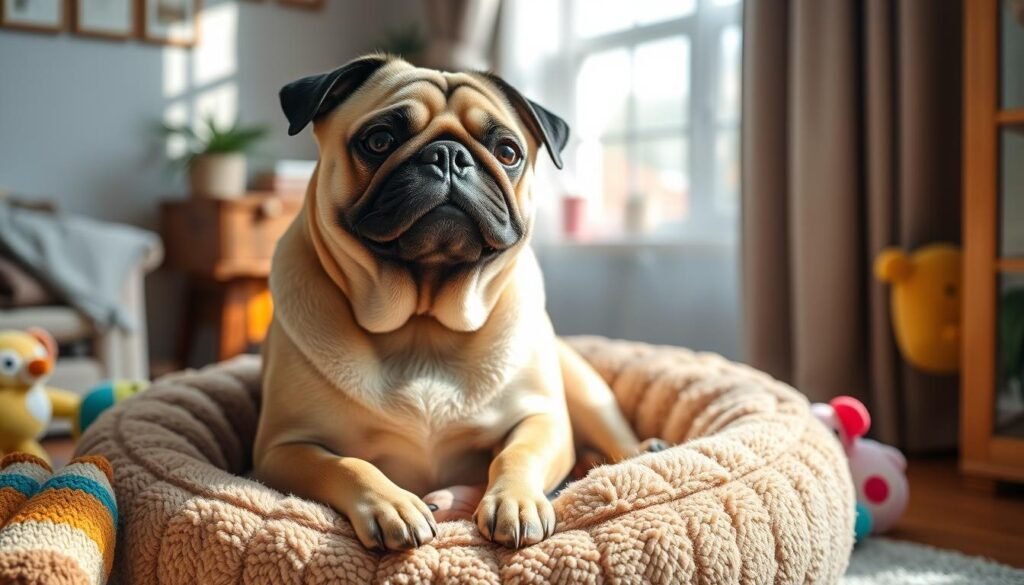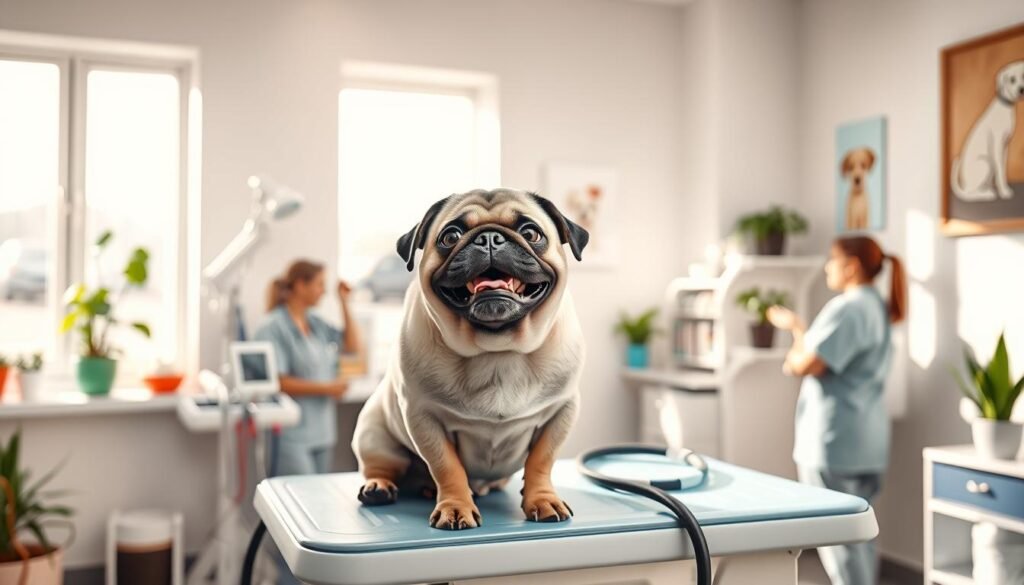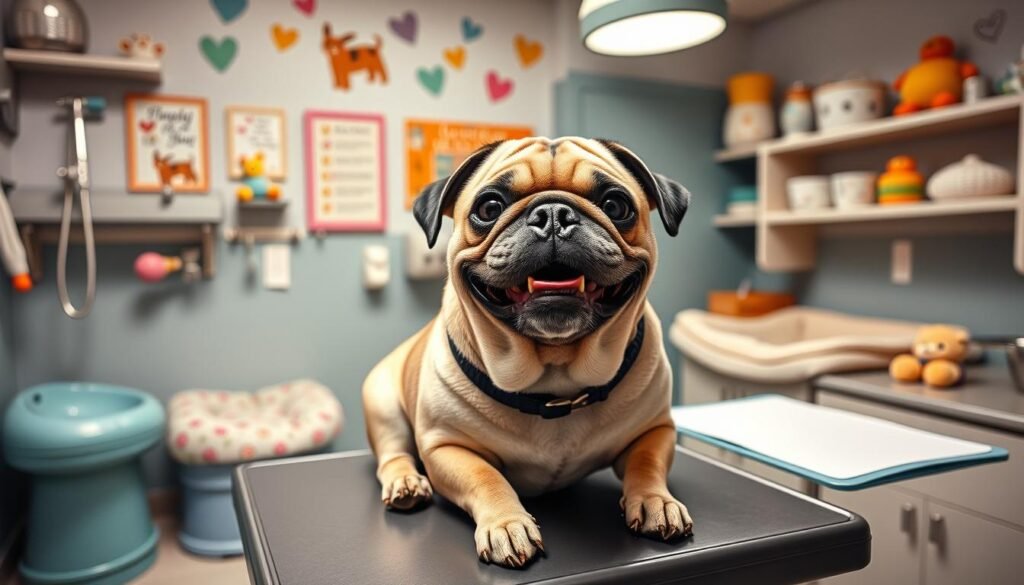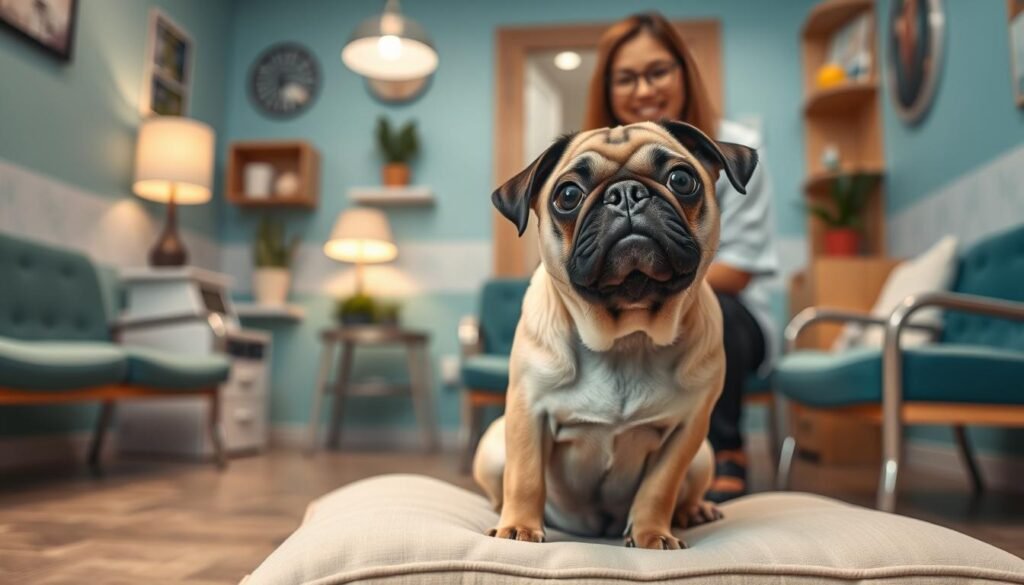How to avoid anxiety during vet visits with your Pug
Pugs are loved pets, but vet visits can be tough for them. On average, dogs visit the vet a few times a year for check-ups and shots. The vet’s office can be scary for Pugs because of the new sights, sounds, and feeling trapped.
But, you can make vet visits better for your Pug. With the right steps, you can help them feel less anxious and more at ease.
This article will share useful tips to make vet visits stress-free for your Pug. You’ll learn how to get your Pug used to the vet’s office and manage their anxiety. By doing this, you can make vet visits a positive experience for your Pug.
Preparing Your Pug for Vet Visits at Home

As a Pug owner, you know your furry friend can get anxious at vet visits. But with some careful preparation and positive reinforcement training at home, you can make them feel better. This way, they’ll be more comfortable and confident during vet check-ups.
Handling Exercises and Positive Reinforcement Training
Begin by teaching your Pug to accept handling exercises at home. Gently touch their paws, ears, mouth, belly, and tail. Always give them praise and treats to make it positive. As they get used to it, you can touch them more.
You can also teach them commands like “stand” and “go to your mat.” This positive reinforcement training helps build their confidence and cooperation at vet visits.
Calm demeanor from the owner can influence the Pug’s behavior positively.”
Your Pug looks to you for cues, so stay calm and reassuring. This calmness helps your Pug feel more at ease during vet visits and handling exercises.
Preparing your Pug at home makes vet visits better and less stressful. Using positive reinforcement during vet visits helps your Pug see the clinic as a place of positive experiences.
Desensitizing Your Pug to the Vet’s Office Environment

Getting your Pug ready for vet visits is more than just home prep. It’s also about getting them used to the vet’s office. This means slowly introducing them to the sights, sounds, and smells in a positive way.
Begin by taking your Pug to the vet for non-medical visits. Here, they can get treats and praise. This makes the vet’s office a place of fun and rewards, not just stress.
Once your Pug gets comfortable, you can make visits longer and more interactive. Bring their favorite toy or treat to make it even better. Always use calming techniques and positive reinforcement during this time.
“Proper desensitization can significantly improve a dog’s behavior during vet visits, reducing the risk of aggression and ensuring a safer environment for both the pet and the veterinary staff.”
By desensitizing your Pug to the vet’s office environment, they’ll feel more relaxed and less anxious. This, along with home handling practice, makes vet visits a positive experience for your Pug.
How to Avoid Anxiety During Vet Visits with Your Pug

Vet visits can be stressful for many Pugs. But, with some preparation and calming techniques, you can ease their anxiety. Bringing your Pug’s favorite treats, toys, or a familiar blanket to the vet’s office can help. These items provide comfort and distract them from their anxiety.
Using calming supplements or pheromone products is another good idea. These products help soothe your Pug’s nerves. They make the vet visit a more positive experience for your furry friend.
Try to schedule vet appointments during quieter times. A less crowded office is less stressful for your Pug. If your Pug still struggles with anxiety, talk to your vet about other options. This could include medication or a referral to a veterinary behaviorist.
Your Pug’s anxiety can be affected by your emotions. So, it’s key to stay calm and confident during vet visits. By using these calming techniques and working with your vet, you can help your Pug have less anxiety during vet visits.
“Addressing your Pug’s anxiety during vet visits is crucial for their overall well-being and the success of their medical care.”
Understanding and Addressing Your Pug’s Anxiety

Signs of Anxiety and Potential Causes
Spotting anxiety in your Pug is key to helping them. They might pace, shake, whine, or hide when anxious. Things like loud sounds, fear of strangers, and being left alone can cause it. Pugs are more likely to have breathing problems because of their face shape, which can make them anxious.
Finding out why your Pug is anxious is important. Some dogs, like Pugs, get really upset when left alone. Talk to a vet or dog trainer to figure out what’s causing it and how to fix it.
“Highly sensitive dogs may react strongly to loud noises, sudden movements, or changes in routine.”
Helping your Pug with anxiety takes time and a few steps. Some dogs handle busy homes and unpredictable schedules better than others. Pugs need a calm and steady place to live.
It’s important to take your Pug to the vet regularly. Pug Dog Encephalitis (PDE) is a serious disease that can make them anxious and tired. Your vet can help manage your Pug’s anxiety and keep them healthy.
Building Confidence and Creating Routines
Helping your Pug feel more confident and following a routine can really help them feel less anxious at the vet. Use positive reinforcement training to make your Pug more self-assured. This helps them stay calm in new places.
Having a regular schedule for meals, walks, and playtime is good for your Pug’s happiness. Giving them a cozy, familiar spot, like their own bed or crate, makes them feel safer at the vet’s.
Using calming methods like pheromone diffusers or soothing music can also help. These, along with building your Pug’s confidence and a set routine, can make vet visits less stressful for them.
Understanding your Pug’s behavior and using calming techniques is crucial. It helps build their confidence and makes vet visits more positive and predictable.
Choosing a Pet-Friendly Veterinary Clinic
Choosing the right vet clinic is key for your Pug’s anxiety during vet visits. Look for a clinic that focuses on reducing stress and making visits positive for your pet.
These clinics have anxiety-reducing features like separate waiting areas for pets. They also use calming scents and train staff in gentle handling. Watch how the staff treats pets and see if your Pug feels comfortable there.
A clinic that knows about Pug behavior and anxiety can help a lot. They might offer:
- Gradual desensitization to the clinic environment
- Positive reinforcement training to associate the vet visit with rewards
- Calming supplements or medications prescribed by the veterinarian
- Techniques to reduce stress, such as pheromone diffusers or music therapy
When picking a vet clinic, look at the staff’s knowledge of Pugs and their approach to anxiety. A clinic that cares about your pet’s comfort can make vet visits less stressful for both you and your Pug.
“A positive veterinary experience can make all the difference in your Pug’s well-being and your own peace of mind.”
When to Seek Professional Help for Your Pug’s Anxiety
If your Pug’s anxiety doesn’t go away or affects their happiness, it’s time to get help. Your vet can check your Pug and suggest treatments. This might include medicine or a visit to a vet behaviorist.
Vet behaviorists are experts in solving pet anxiety problems. They can help you make a plan to manage your Pug’s anxiety. They might suggest training to help your Pug feel better in different situations.
It’s important to tackle your Pug’s anxiety early. If you don’t, it could get worse. With a vet’s help, your Pug can feel more at ease. This way, they can live a happier life.

